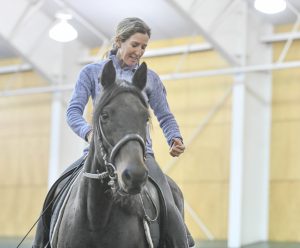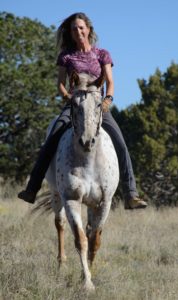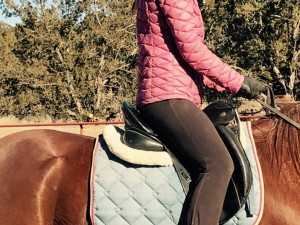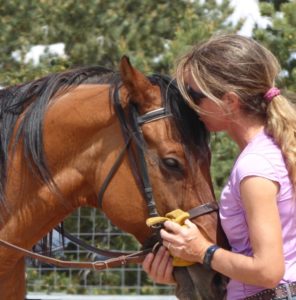
Katrin Silva at the 2019 Summit. Photo by Nina Fuller
Editor’s Note: Best Horse Practices Summit presenter Katrin Silva grew up riding dressage in Germany before moving to the United States at age 19 to learn to ride Western. She’s been riding both disciplines for the last twenty years and is a regular guest columnist for Cayuse Communications. She lives in New Mexico where she works with dressage and Western clients. Visit her blog here.
Buy her book, Dressage for All of Us here.
Katrin writes:
Like most of the world in this surreal spring of 2020, New Mexico is under COVID-19 lockdown. Only essential businesses remain open.
I’m grateful that those of us responsible for horses’ basic needs are considered essential. Exercise, as we know, is just as basic a need as feed and water. Horses are made to move, whether there’s a virus wreaking havoc with human lives or not. If horses don’t exercise, their minds and bodies suffer. Horses can’t just spend time on the sofa, like most of us do in times of social distancing, but the nature of “exercise” remains open to interpretation. I choose to interpret “exercise” as “riding” more often than not.

Katrin Silva
Why ride while in quarantine?
There are no shows on the horizon, no clinics to get ready for. The New Mexico Livestock board sent out a letter urging horse owners to cut their activities down to a minimum. By most standards, climbing on a horse’s back is not essential for the horse’s welfare. The owners of the horses in my care would understand if I followed the rules literally. They would not mind if their horses got a break from riding. I could just turn them out or lunge them. The horses would be ok. I know that.
And yet, I still find myself on a horse all day, most days. When I don’t ride for a day or two, I miss it. I crave it. Even if I didn’t get paid to do it, I’d still do it – because I want to, because I need to.
In my twenties, I climbed on any horse – bucking, bolting, rearing. You name it. Now that I’m 50, I’d rather teach horses they don’t need to buck or bolt, which means doing more ground work before I get on. I take more time in the round pen than I used to. I’ve learned how to use a double lunge without getting tangled up in it, at least most of the time. But when I have a choice, I still would rather ride.
Riding a horse means connecting to that horse in a physical sense that makes our partnership more solid. When things are going well, my back feels what the horse is about to do. I communicate with the horse’s body directly, taking feedback and responding immediately with my seat, legs, and fingers. I don’t have to think about what I’m doing. My frontal cortex is taking a back seat in this ongoing conversation.

Silva: When my back is tense, my horse’s back will be, too. When my back is relaxed, my horse’s back will be, too.
We can’t have this kind of intense, nuanced dialogue with other species. We can, of course, communicate with dogs and cats, even with dolphins. They learn follow our voice commands. They also learn to understand our body language, and we theirs. But our bodies are not connected in this unique way. We don’t move our spines in rhythm with theirs.
Sometimes I wonder how many species early humans tried to ride before they figured out horses were the best choice. I wonder how those early horseback riders figured out how to influence horses’ speed and direction by using their bodies.
Once I felt the horse’s back talk to my back, my relationship with horses changed from a little girl’s wide-eyed worship to a deep and lifelong passion. Ever since, I’ve been trying to learn that language, to understand it better, to speak it better.
In the 21st century, keeping horses in our lives makes no sense from a practical point of view. They’re too large to make good pets. They need lots of space. They cost lots of money. They take up time that most of us don’t really have.
Riding them can make even less sense. It’s expensive, labor-intensive, and sometimes dangerous. Horses can live happily without carrying us around. Animal rights groups argue that riding horses is inherently cruel. According to PETA, “the decision to take part in horseback riding is made solely by one individual with little benefit to and no input from the other.”
So, why do so many of us still ride?
 To some, horseback riding is a status symbol, a membership to an exclusive club that, because of its exorbitant price tag, keeps out the hoi-polloi. But for most of us, horseback riding is all about the unique connection with another living creature. In these unsettled times, we need horses more than we ever have. As social distancing becomes the new normal, being on a horse feels like hugging someone. As social media replaces real-life relationships, being on a horse reminds us that honest, polite conversation works better than pretense or anger. As anxiety encroaches on every aspect of our lives, riding a horse forces us to be present in the here and now.
To some, horseback riding is a status symbol, a membership to an exclusive club that, because of its exorbitant price tag, keeps out the hoi-polloi. But for most of us, horseback riding is all about the unique connection with another living creature. In these unsettled times, we need horses more than we ever have. As social distancing becomes the new normal, being on a horse feels like hugging someone. As social media replaces real-life relationships, being on a horse reminds us that honest, polite conversation works better than pretense or anger. As anxiety encroaches on every aspect of our lives, riding a horse forces us to be present in the here and now.
While I ride, fears and worries fade into the background.The chaos of the world seems far away. All that matters is the rhythm of the horse’s gaits. All that matters is the gently rocking motion of the horse’s back. There is nothing more calming for the human spirit than riding a horse at a walk, feeling his legs go one-two-three-four, There’s nothing more energizing than riding a brisk, bouncy trot. There’s nothing more joyful than riding a big, rolling canter.
It’s true: we need horses much more than they need us, especially now.